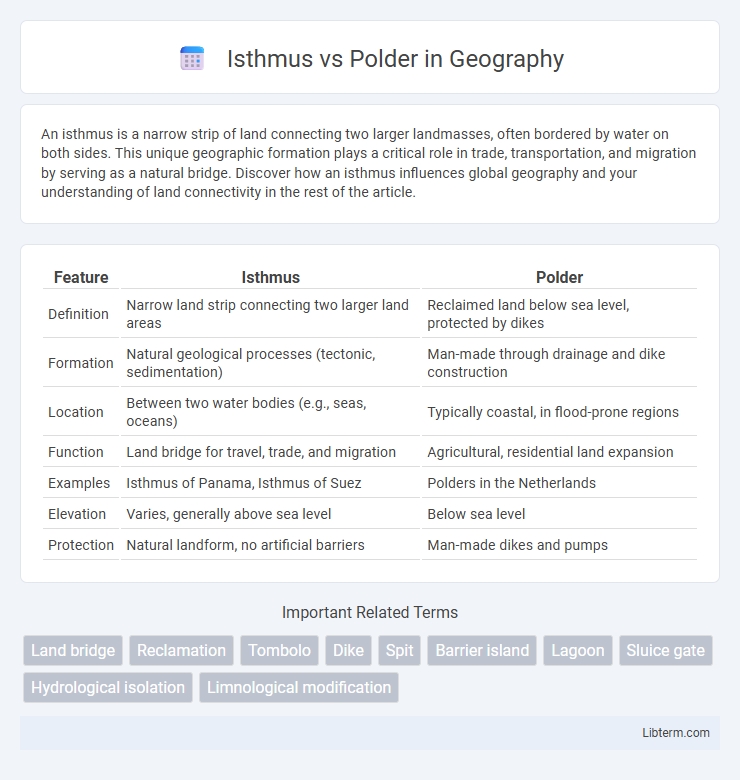An isthmus is a narrow strip of land connecting two larger landmasses, often bordered by water on both sides. This unique geographic formation plays a critical role in trade, transportation, and migration by serving as a natural bridge. Discover how an isthmus influences global geography and your understanding of land connectivity in the rest of the article.
Table of Comparison
| Feature | Isthmus | Polder |
|---|---|---|
| Definition | Narrow land strip connecting two larger land areas | Reclaimed land below sea level, protected by dikes |
| Formation | Natural geological processes (tectonic, sedimentation) | Man-made through drainage and dike construction |
| Location | Between two water bodies (e.g., seas, oceans) | Typically coastal, in flood-prone regions |
| Function | Land bridge for travel, trade, and migration | Agricultural, residential land expansion |
| Examples | Isthmus of Panama, Isthmus of Suez | Polders in the Netherlands |
| Elevation | Varies, generally above sea level | Below sea level |
| Protection | Natural landform, no artificial barriers | Man-made dikes and pumps |
Introduction to Isthmus and Polder
An isthmus is a narrow strip of land connecting two larger land masses, often bordered by water on both sides, playing a crucial role in geography and transportation. A polder is a low-lying tract of land reclaimed from a body of water, such as a lake or the sea, typically surrounded by dikes and managed through drainage systems, commonly found in the Netherlands. Both landforms illustrate human interaction with natural landscapes, where the isthmus connects regions, and polders create new arable land through engineering.
Defining Isthmus: Key Features
An isthmus is a narrow strip of land connecting two larger landmasses, often bordered by water on both sides, serving as a crucial natural land bridge for migration and transportation. Key features include its strategic geographic position, presence between two bodies of water, and significant ecological and economic importance. Unlike polders, which are reclaimed lands enclosed by dikes, isthmuses form naturally without artificial intervention and maintain distinct ecosystems influenced by surrounding marine environments.
Defining Polder: Key Features
A polder is a low-lying tract of land reclaimed from a body of water, such as a lake or the sea, through the construction of dikes and drainage systems. Key features of a polder include controlled water levels maintained by pumps and canals, fertile soil due to sediment deposition, and artificial barriers that prevent flooding. Unlike an isthmus, which is a natural landform connecting two larger land areas, a polder is a human-engineered landscape primarily found in countries like the Netherlands.
Formation Processes: Isthmus vs Polder
An isthmus forms naturally through geological processes such as sediment deposition and tectonic activity, creating a narrow land strip connecting two larger landmasses. In contrast, a polder is artificially created by human intervention, involving land reclamation through the construction of dikes and drainage systems to control water levels in low-lying areas. While isthmuses develop over long geological timescales, polders result from engineered modifications to existing aquatic or marshy environments.
Geographical Examples: Isthmus Around the World
The Isthmus of Panama, connecting North and South America, serves as a critical land bridge facilitating global maritime trade via the Panama Canal. The Isthmus of Suez links Africa and Asia, hosting the strategically vital Suez Canal, a major route for international shipping. Other notable isthmuses include the Isthmus of Kra in Thailand and the Isthmus of Corinth in Greece, both significant for their geographical positioning and historical importance.
Notable Polders and Their Locations
Notable polders include the Netherlands' Zuidplaspolder near Rotterdam, one of the lowest points in Europe, and the Flevopolder, the largest artificial island, located in Flevoland province. In Belgium, the Zwin polder near Knokke-Heist demonstrates significant coastal land reclamation efforts. These polders showcase advanced water management and land reclamation techniques distinct from natural landforms like isthmuses.
Human Influence: Polders vs Natural Isthmus
Polders exemplify significant human influence by transforming wetlands into reclaimed land through dikes and drainage systems, showcasing advanced water management and land reclamation techniques. Natural isthmuses form through geological processes without direct human intervention, maintaining ecosystems shaped by natural sediment deposition and erosion patterns. Human modifications of polders often alter regional hydrology and ecosystems, contrasting with the relatively stable and naturally preserved environments of isthmuses.
Environmental Impact and Ecosystems
An isthmus, as a natural land bridge connecting two larger landmasses, supports diverse terrestrial and marine ecosystems by allowing species migration and genetic exchange. Polders, reclaimed lands protected by dikes mainly found in the Netherlands, drastically alter natural wetlands and aquatic habitats, often disrupting local biodiversity and water cycles. Environmental impacts of polders include increased soil subsidence and changes in salinity, which can degrade surrounding ecosystems and reduce resilience to climate change.
Comparing Uses and Significance
An isthmus serves as a strategic land bridge connecting two larger landmasses, essential for transportation, trade, and geopolitical control, exemplified by the Isthmus of Panama facilitating global maritime navigation through the Panama Canal. A polder, created by reclaiming land from water bodies using dikes and drainage systems, is significant for agricultural expansion and urban development in regions like the Netherlands, where it increases cultivable land and protects against flooding. While an isthmus naturally links territories enhancing connectivity, polders represent human-engineered landscapes optimizing land use and water management.
Summary: Isthmus vs Polder – Main Differences
An isthmus is a narrow land strip connecting two larger land areas, typically surrounded by water on both sides, serving as a natural land bridge. A polder is a low-lying tract of land reclaimed from a body of water, such as a lake or the sea, protected by dikes and managed through drainage systems. The main differences lie in origin and purpose: isthmuses are natural formations facilitating land connection, whereas polders are engineered landscapes created for agriculture or habitation.
Isthmus Infographic

 libterm.com
libterm.com